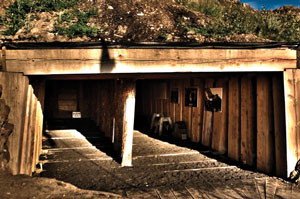
The Atlas Coal Mine is starting to explore a little further underground.
The National Historic Site in East Coulee is coming off another successful tourism season and it is no wonder. It is a showcase for the valley’s rich history of mining. It is also the year the centennial of coal mining in Drumheller is being celebrated. It is home to the famous tipple and this was the third year of operation with the conveyor causeway open to foot traffic giving visitors an underground experience.
This summer the mouth of the coal mine was opened. It has been sealed up since 1956. The next question for the Atlas Coal Mine is how far will they go? Or rather, how deep?
During the last 12 months, the Atlas took the first step in opening the mine. Last fall, they retimbered the first 35 feet of the mine entrance. The Drumheller and District Chamber of Commerce, the World’s Largest Dinosaur Legacy Fund, the Government of Canada Economic Action Plan, the Rural Alberta Development Fund, a Canadian Badlands partnership grant and the Allard Foundation supported this project.
This spring, the Atlas finished making it visitor ready and this summer visitors were able to venture in.
“They (visitors) really liked, it, they thought it was a cool, evocative space and they all said ‘when are you going deeper?'” said Linda Digby of the Atlas Coal Mine. “They want us to go deeper, and in fact, that was always the intent of the board - that we would go deeper.”
“Exactly how we approach it depends on how deep the earth plug is."
The mine atop the hill was closed in 1956. According to documents, Digby said they went into the mine about 300 feet and blasted down a piece of roof to seal off mine air. Further toward the entrance they cribbed the mine with wood and then sealed the entrance with earth.
The question is how thick is the soil plug. To find this out, they are looking at finding a way to probe through to get an idea.
“We don’t really know how thick the soil plug is. We have had engineers and geologist thinking about it and making estimates, but we don’t really know. If we could do a probe, that would give us a lot of information to make a good plan. So, when we sit down with our regulating agencies, we have some data to work with.”
She adds, that because of the cribbing, they are confident that when they are able to enter the mine further, the tunnel will be stable.
The plan is to go in about 100 feet total. This, according to local accounts, could get them into a “pit cabin,” an underground office, and a bench carved out of the mine wall. This space will allow visitors to experience underground, but also allow them to see the seam of coal that was being exploited. The project won’t go as far as actual mine workings.
“We would have to go about a kilometre to get to workings,” said Digby. It will be in the main haulage... I think what will make it neat will be the geology that is revealed and the timbered space and that feeling of going deeper into the earth, seeing that coal seam. That coal seam is the purpose for this whole site.”
Right now, the Atlas Coal Mine has a call out to the community looking for proper equipment that could help complete a probe for the next step, deeper.
















